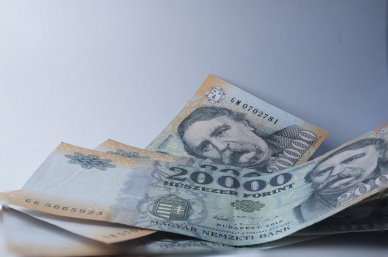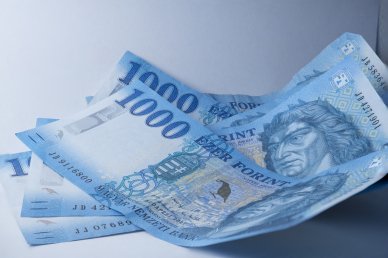The Hungarian Forint
The Hungarian Forint (HUF) is the official currency of Hungary. It is a freely convertible currency and circulates only within the country’s territory. The fractional coins have become defunct due to soaring inflation.
History

Forint is a distorted Hungarian name of the Italian coin of florin that became a sample for minting coins in the Kingdom of Hungary in the 14th century. The title ‘forint’ remained to be used by people after the country became a part of Austria-Hungary, where the krone was circulating as the new currency.
After the fall of the Habsburgs, Hungary gained independence in 1921. Besides, it also got its money called Hungarian krones, which were defunct in four years.
In 1925, after the formation of the Hungarian People’s Republic, the country had another means of payment called the pengo that existed till the end of World War II.
In 1946, the pengo was defunct, and the forint returned as the official currency of Hungary. There was an exorbitant exchange rate of 4х1029 P for Ft 1.
The gold content of HUF equalled 0.0757 gr. The peg to the US dollar took place with the exchange rate of 11.7:1. After some time, the rate dropped to 309 HUF/USD at the beginning of the 21st century. At present, Ft1 equals $0.034.
Since 2015, the forint has been included in the list of freely convertible currencies.
Design
The first forint banknotes were issued in 1946 in the denominations of 10 HUF and 100 HUF. The series was updated in the following two years and extended with banknotes of 20 HUF.
The other denominations appeared one by one due to the ongoing inflation. In 1953, the 50-forint banknotes emerged, in 1970 - 500 HUF, in 1983 and 1991 - 1,000 HUF and 5,000 HUF.
The modern series of the Hungarian currency issued during 1997 - 2001 consists of seven denominations. The banknotes do not contain watermarks, but the security features constitute the two security strips. Only the 1,000-forint notes include the holographic strips.
In 2000 and 2006, the commemorative banknotes were issued as a dedication to the two significant events in the life of a country:
- 2000 - the 1,000-forint and 2,000-forint banknotes to commemorate the millenary of Hungary;
- 2006 - 500-forint banknote to commemorate the 50th anniversary of the Hungarian Revolution of 1956.
The Hungarian National Bank is in charge of issuing the official currency, and the Hungarian Mint is responsible for minting the coins. The paper money manufacturing sites are located in Budapest and Miskolc at the Hungarian Banknote Printing Corp. and Diósgyőr Papermill.
Coins

The fractional coins called fillers became defunct in 1999. At present, there are coins in the denominations of 5 Ft, 10 Ft, 20 Ft, 50 Ft, 100 Ft, and 200 Ft. A new series was released on January 1, 2012, when the country’s government decided to change its official name to ‘Hungary’, which has become enshrined in the constitution.
The Hungarian coins are minted of brass and the alloy of copper and nickel. The bimetallic 100-forint and 200-forint coins are made of ply steel. The ring of 100 HUF is covered with nickel and its middle - with brass. The ring of 200 HUF is made of brass, and its middle - of copper and nickel alloy.
Banknotes

Previously, there were two series of banknotes of Hungarian forints in circulation - 1997-2013 and 2014-2018.
The first was released in seven denominations with measures of 154 mm by 70 mm for all banknotes.
- 200 HUF is a green banknote that depicts a portrait of King Charles Robert on the obverse and the Castle of Diósgyőr on the reverse.
- 500 HUF is an orange banknote that features Prince Francis II Rákóczi on the obverse and the Castle of Sárospatak on the reverse.
- 1,000 HUF is a blue-and-yellow banknote with the portrait of King Matthias I on the obverse and the Hercules Fountain on the reverse.
- 2,000 HUF is a brown banknote that features Gabriel Bethlen on the obverse and the painting “Gábor Bethlen among his scientists" on the reverse.
- 5,000 HUF is a violet-and-green banknote with the depiction of Count István Széchenyi on the obverse and his family mansion on the reverse.
- 10,000 HUF is a red banknote with a portrait of King Stephen I on the obverse and the painting of Hubert Sattler on the reverse.
- 20,000 HUF is a grey banknote that features the portrait of politician Ferenc Deák on the obverse and the image of the Hungarian Parliament building on the reverse.
There have also been three commemorative banknotes. The first one was the 500-forint note dedicated to the 50th anniversary of the Hungarian Revolution with its flag and the Parliament building on the obverse. The 1,000-forint banknote was issued to commemorate the Millenium. The portrait of King Saint Stephen and the painting of Gyula Benczúr embellish the 2,000-forint commemorative note.
In September 2014, after the name of the republic changed, its government announced gradual re-issuance of all paper money to protect all banknotes from counterfeiting. It was decided not to change the design (except for colour arrays).
The first banknote of a new series was 10,000 HUF issued at the beginning of September. In a year, the 20,000-forint notes were released. In November 2016, the new 2,000-forint and 5,000-forint notes replaced the older ones.

Hungarian 20,000-forint notes
In 2017 and 2018, the banknotes of 1,000 HUF and 500 HUF appeared one after another. Besides, all the notes from a former series were replaced till September 1, 2019.

Hungarian 1000-forint notes
Circulation in the World
Even though the Hungarian forint is included in the list of freely convertible currencies, it is almost not used in the stock exchange and exchange rate transactions. The floating exchange rate that directly depends on the rate of inflation in the country has been set.
